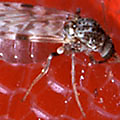What Do Noseeums Look Like Funny
No-See-Ums

No-See-Ums are also referred to as Biting Midges, Biting Gnats, Punkies or Sand Flies. They are so small they can get through screens on windows and doors. Besides causing painful bites, they can also be vectors of diseases, particularly in tropical regions. If your yard is a breeding ground for No-See-Ums, then a No-See-Ums trap may be just the solution to your insect problems.
Even if a No-See-Ums is not a vector of disease, it can still be a pest, ending up in a person's mouth, nose, ears and eyes.
Description | Breeding | Geography | Interesting Facts
Description
No-See-Ums are also referred to as Biting Midges, Biting Gnats, Punkies or Sand Flies. With grayish or yellowish bodies, the adults resemble mosquitoes, although they are smaller than mosquitoes. In fact, they are so small they can get through screens on windows and doors.
Besides causing painful bites, they can also be vectors of diseases, particularly in tropical regions. These pests are very well-known among anybody that spends considerable time outdoors.
No-See-Ums have the same four-stage life cycle as mosquitoes. After she has a bloodmeal for the development of her eggs, the female No-See-Um will lay her eggs on water, mud or a wet sandy area. Eggs are a whitish shade at first, but they will gradually darken.
After an egg hatches, the white worm-like larva will begin to eat organic matter. It has a protuberance which allows it to breathe in its surroundings. After approximately 28 days, the larva will pupate at the surface, turning into an adult No-See-Um. After eating, the adult No-See-Um will mate and the cycle will continue.
Both male and female No-See-Ums eat nectar for energy and nourishment, but only the female will bite humans to draw blood for egg development. These tiny biters are usually active at dawn and dusk, especially during the middle to the end of summer. Their bite can be very painful, with the welts lasting for several days. Although some people will have the discomfort of the bite, others can develop allergic reactions or other problems which will need medical attention.
In some countries, particularly in tropical regions, these insects can be transmitters of parasites and diseases such as filarial worms in humans and bluetongue virus in livestock. Besides causing discomfort and skin lesions, the parasitic worm's affliction requires medical attention. Economic ruin can occur for the agricultural sector of an area endemic with bluetongue.
Even if a No-See-Um is not a vector of disease, it can still be a pest, ending up in a person's mouth, nose, ears and eyes. This can lead to economic problems as tourists may be driven from a particular area that has been infested by these annoying, vicious little insects.
Breeding Habits
The female No-See-Um will lay her eggs in a wide range of locations. No-See-Ums breeding grounds include lakes, ponds, treeholes, moist soil and even in plants that are able to retain pockets of water. No-See-Ums breeding grounds along seashores are in wet sand, which is where females often lay their eggs. The No-See-Ums breeding grounds can differ by species.
After mating with a male usually in the midst of a large swarm, the female No-See-Um can lay 400 or more eggs at one time. This breeding can take place 5-7 times during her adult life.
With as quickly as these insects progress through their life cycle, it's easy to see why there can be tremendous populations of these No-See-Ums swarming around a particular region.
Geography
Where do No-See-Ums live?
No-See-Ums can be found throughout the world. There are about 4,000 to 5,000 currently known species of these biting midges. Their range includes tropical, sub-tropical, sub-Saharan and temperate regions, as well as areas with cooler climates.
These annoying little vectors can be found in fresh water habitats as well as salt-water marshes, depending on the preference of the species.
Interesting Facts
Both No-See-Ums and Gull Midges are the only pollinators of the cacao tree, from which we get cocoa beans for our chocolate.
Although the larval stage generally takes about 28 days, it can last up to a year in certain species in cold climates.
In tropical regions, larvae can even be found in rotting fruit.
Scotland is known for its "biting midges," as these pests are called there. Depending on their species, these flies will bite other insects, birds and mammals, including humans. The most prevalent midge in many parts of Scotland is the Highland midge which prefers to breed in woodland, pastures and areas with particular moor grasses. There is concern that these biters can affect outdoor workers as well as tourists. This creates a need for effective protection against No-See-Ums.
Blue Tongue is a disease transmitted to livestock but not to humans.
Insecticides, larvicides and repellents are either useless or very limited in their success in fighting No-See-Ums. Even DEET offers only limited No-See-Ums protection.
There are screens which are of a much narrower weave that can be used on windows to help prevent no-see-ums from entering a home. Regular size screens have too wide of spacing between the weaving to prevent the entry of these tiny pests.
Midges have been found on Mount Everest!
No-see-ums are known as "knotts" in Norway, "Moose Flies" in Canada and "meanbh-chuileag" (tiny fly) in Gaelic-speaking countries.
It is believed that biting midges are drawn to mammals, including humans by detecting certain odors we emit, particularly the odor of carbon dioxide and the odor of lactic acid. That means that CO2 mosquito traps offer an effective form of No-See-Um protection.
 Protect your family, pets and guests from annoying no-see-ums with a Mosquito Magnet® trap - the leading long-term, scientifically-proven no-see-um control solution
Protect your family, pets and guests from annoying no-see-ums with a Mosquito Magnet® trap - the leading long-term, scientifically-proven no-see-um control solution
Source: https://www.mosquitomagnet.com/advice/mosquito-info/biting-insect-library/no-see-ums
0 Response to "What Do Noseeums Look Like Funny"
Post a Comment